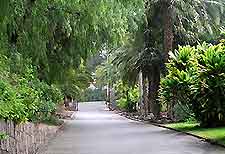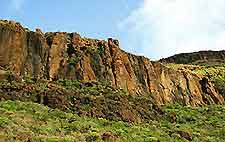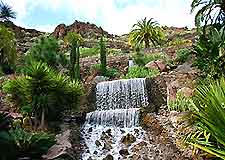Gran Canaria History Facts and Timeline
(Gran Canaria, Canary Islands, Spain)

Gran Canaria is a volcanic island which is home to the largest city in the Canary Islands, Las Palmas. It also features a variety of landscapes and climates, leading many commentators to describe the island as a miniature continent. The island is now best-known as a package-tour destination, but the rich history of Gran Canaria offers visitors plenty of alternative distractions to the beach.
It is believed that the first settlers arrived on the island around the 5th century BC, from North Africa. These settlers were Berber in origin and known as Guanches, with the tribe making this island their home. They named the island Tamarán, which means 'Land of the Brave'.
European Conquest on Gran Canaria
The first incursions into Tamarán territory began in the early 14th century, led by intrepid explorers from both
France and
Portugal. However, it was the Kingdom of Castile, a precursor to present-day Spain, which was the first European power to finally conquer the island. The campaign was sponsored by Queen Isabella I and lasted in the region of five years, before control was eventually gained in 1483.
The capital, Las Palmas de Gran Canaria, had already been established several years earlier, in 1478, after Castilian naval captain Juan Rejón's invading forces poured onto the island to fight the Guanches. At that time, the city was named 'Real de Las Palmas'.

Christopher Columbus
Renowned explorer Christopher Columbus arrived in Gran Canaria as part of his expedition to the Americas in the year of 1492. He also stopped off here on his return journey, which in turn led the Casa Colón Museum to be named in his memory. The museum consists of several houses, one of which was once home to Columbus himself. The museum is located in the historic Vegueta district of Las Palmas, where it covers the history of the Canary Islands and its links to America.
European Raids
The Kingdom of Castile's grip on Gran Canaria was far from firm during the first couple of centuries of its rule. In 1595, the British seaman Francis Drake was unsuccessful in his attempt to plunder the island in what is now known as the 'Battle of Las Palmas'. Drake's men attacked the fortresses of Santa Caterina and Santa Ana in Las Palmas. The Spanish performed a magnificent rearguard action, severely damaging four English ships and forcing Drake's men to retreat.
This plundering attempt was followed with a second raid in 1599, by a Dutch fleet led by Vice Admiral Pieter van der Does. Las Palmas was partially destroyed in this second raid and it is considered to be one of the most significant events in the history of Gran Canaria.

20th-Century Developments
The seeds of the Spanish Civil War were sown in July of 1936, when General Franco launched a coup out of Las Palmas. However, the years following the war were much more prosperous ones in Gran Canaria history, especially when the Suez Canal was closed during periods of Arab-Israeli tension.
It was then that Gran Canaria's seaport offered convenient facilities for ships taking on less direct routes between the northern and southern hemispheres. However, from the 1960s onwards, the island's economy has been driven by tourism, primarily focused on the beaches in the southern part of the island.
 Gran Canaria is a volcanic island which is home to the largest city in the Canary Islands, Las Palmas. It also features a variety of landscapes and climates, leading many commentators to describe the island as a miniature continent. The island is now best-known as a package-tour destination, but the rich history of Gran Canaria offers visitors plenty of alternative distractions to the beach.
Gran Canaria is a volcanic island which is home to the largest city in the Canary Islands, Las Palmas. It also features a variety of landscapes and climates, leading many commentators to describe the island as a miniature continent. The island is now best-known as a package-tour destination, but the rich history of Gran Canaria offers visitors plenty of alternative distractions to the beach.
